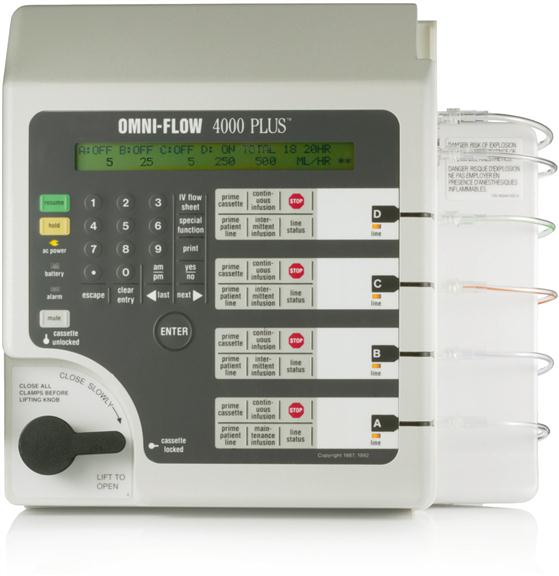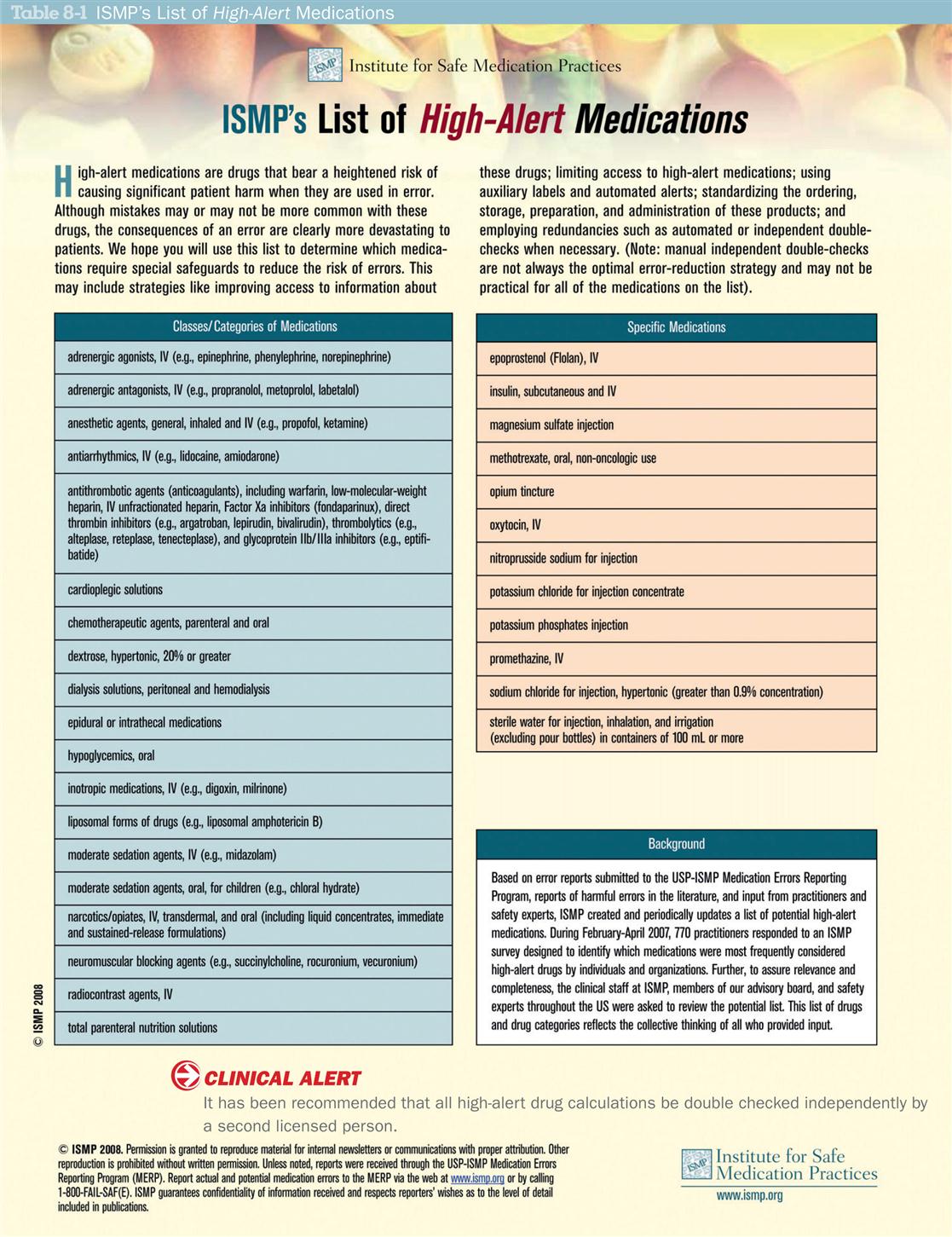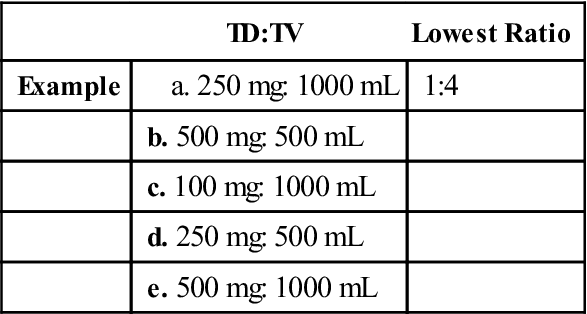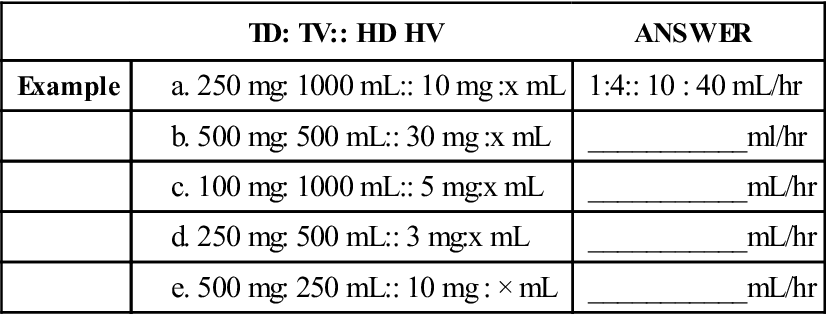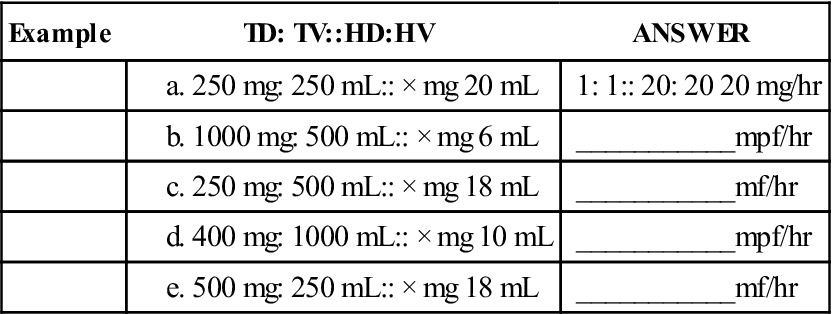Advanced Intravenous Calculations
Objectives
• Calculate milligrams per kilogram and micrograms per kilogram per minute and per hour.
• Calculate hourly drug dose and hourly flow rate for IV solutions.
• Estimate and calculate infusion rates and drug doses using ratio and proportion.
• Calculate time and dose intervals for direct IV push (bolus) medications administered by a syringe.
Introduction
This chapter builds on the mastery of the basic IV calculations learned in Chapter 6. Taking the time to work through each set of problems will facilitate the acquisition of the logic needed to solve complex IV solution calculations. When each step has been mastered, you will be able to identify and use basic safe calculation shortcuts.
Advanced IV Calculations
Advanced IV calculations are used to determine the amount of IV drug and flow rate per minute and/or per hour for HIGH-ALERT potent medications based on the patient’s weight, condition, and response to treatment. If an infusion device is not available, microdrip tubing should be used with a volume-control device (Figure 8-1 on page 182). High alert medications must be delivered on an IV pump.
The choice of administration and equipment depends not only on the orders and the patient’s condition but also on hospital policy, accrediting body policy, the current literature and pharmacy recommendations, and the equipment available.
The nurse must be able to evaluate orders and existing solutions for safe and correct dose/flow rates, preferred routes, and compatibilities with existing solutions. Table 8-1 provides the ISMP’s list of High-Alert medications.
Titrated Infusions
Dose/flow rate adjustments may be made, particularly with powerful solutions of medications, based on the patient’s condition, weight, and physiologic response to the medication. For example, an order may call for an IV to be titrated (adjusted) to maintain a certain blood pressure range. The most potent IV medications are administered and adjusted in micrograms per kilogram per minute or milligrams per kilogram per minute. For purposes of reducing errors and simplifying mathematics in flow rate calculations, many of these infusions now have a standardized total drug/total volume ratio of 1 : 1, 1 : 2, and 1 : 4 (e.g., 250 mg/250 mL [1 : 1]; 250 mg/500 mL [1 : 2], 250 mg/1000 mL [1 : 4]). If the patient requires fluid restriction, the physician may order a stronger concentration of drug to solution (4 : 1 or 2 : 1 drug in solution, such as 1 g : 250 mL [4 : 1] or 500 mg : 250 mL [2 : 1]).
 CLINICAL ALERT
CLINICAL ALERT
If you consult flow rate and compatibility charts, examine the source and the date published. If the publisher is a reputable source, such as the laboratory that furnishes the IV solutions in use, and if the chart is current, then take further care to examine the layout and content of the tables to ensure that the information needed is selected.
IV solutions that contain powerful medications are usually prepared by the pharmacy and administered by a volumetric infusion pump. There are several sophisticated devices on the market (Figure 8-1). The data to be entered can range from the traditional mL/hr to drug doses ordered per minute in mg/min or mcg/min, along with the patient’s weight, if necessary (mg/kg/min) (Figure 8-2).
New High Technology Infusion Devices Called “Smart Pumps”
A variety of infusion pump devices have been developed to reduce medication errors. Grave adverse drug events with powerful IV pump-infused drugs have occurred due to programming errors such as entering mL for mg, mg for mcg, or pounds for kg.* The smart pumps are preprogrammed with specific guidelines on kg weight-based dose limits, and usual doses for drugs used in specialized clinical areas such as adult and infant ICU areas, obstetrics, and so on. Hospital pharmacies often manage the multiple sources of preprogrammed software information including drug libraries and specific patient care area safe dose ranges.
The nurse selects the drug from the software on the pump, enters the drug concentration, the order, and the patient’s weight in kg to obtain the flow rate and is “alerted” if the data entered exceed safe dose limits for the target population. Some smart pumps also alert the nurse if the same drug is being infused on another line. All alerts are logged so that problems can be audited by the agency’s safety committees.
 CLINICAL ALERT
CLINICAL ALERT
Interpretation of drug concentrations on labels; awareness of differences among mcg, mg, mL, and units, and the difference between lb and kg; familiarity with safe dose ranges for the target population, pump equipment operation, and potential equipment flaws all are essential to safe administration. The nurse has a chance to confirm all the data before initiating the flow of the drug.
 CLINICAL ALERT
CLINICAL ALERT
Although these pumps can reduce errors, the nurse cannot be overly reliant on pump alerts. The alerts depend upon the accuracy and scope of preprogrammed information as well as the function of the pump.
Solving Titrated Infusion Problems
Hourly Drug and Flow Rate Formula for Titrated Infusions

remember
IV orders may necessitate converting mcg or mg/min to mg/hr.
 Example
Example
Ordered: 3 mcg/kg/min of Intropin (dopamine HCl) for a new patient with heart failure. Available: 400 mg dissolved in 500 mL D5W. The literature recommends an initial dose of 2 to 5 mcg/kg/min, (not to exceed a total of 50 mcg/kg/min). The dose is to be titrated to the patient’s systolic blood pressure at the level ordered by the physician. This patient weighs 242 lb. What flow rate should be set?
Step 1
Step 2
Compare the SDR recommended in the literature with the order:
 CLINICAL ALERT
CLINICAL ALERT
Titrated infusions seldom require a high flow rate. It is essential that the flow rates be correct. Speeding up or slowing down an IV without a physician’s order, to compensate for incorrect flow rate, is hazardous. Be aware that abrupt changes in the flow rates of IV fluids and therefore in medication levels can cause serious side effects.
Step 3
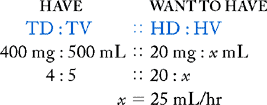
Set the flow rate on the IV infusion device to 25 mL/hr.
Alternative Step 3
If the hourly volume is known but the hourly drug dose is not, just place the unknown (x) under the hourly drug dose and fill in the hourly volume ordered in this equation. Check the answer with the literature for the SDR (e.g., the order was for 25 mL/hr or is infusing at 25 mL/hr when you arrive; how much drug is the patient receiving per hour and per minute so that the SDR can be checked?).
Use the same formula. Read the total drug, total volume, and hourly volume on the IV devices in the patient’s room:

The SDR states 2 to 5 mcg/kg/min. Now you know that the order was followed properly, and that the flow rate is correct and within the SDR. The next few worksheets provide the necessary basic skills practice to understand and perform these calculations rapidly.
Example
| Drug/kg/min | Weight | mcg/hr | mg/hr | |
| Example | a. 5 mcg/kg/min | Wt: 5 kg | 5 × 5 × 60 = 1500 |  |
b. 8 mcg/kg/min | Wt: 20 kg | __________ | __________ | |
c. 3 mcg/kg/min | Wt: 121 lb | __________ | __________ | |
d. 4 mcg/kg/min | Wt: 50 kg | __________ | __________ | |
| Wt: 60 kg | __________ | __________ |

Example
Example
Estimate the hourly drug (x).
Example
Example
Tip: Being able to convert drug, weight, time, and volume parameters within the metric system with ease facilitates advanced IV calculations.
